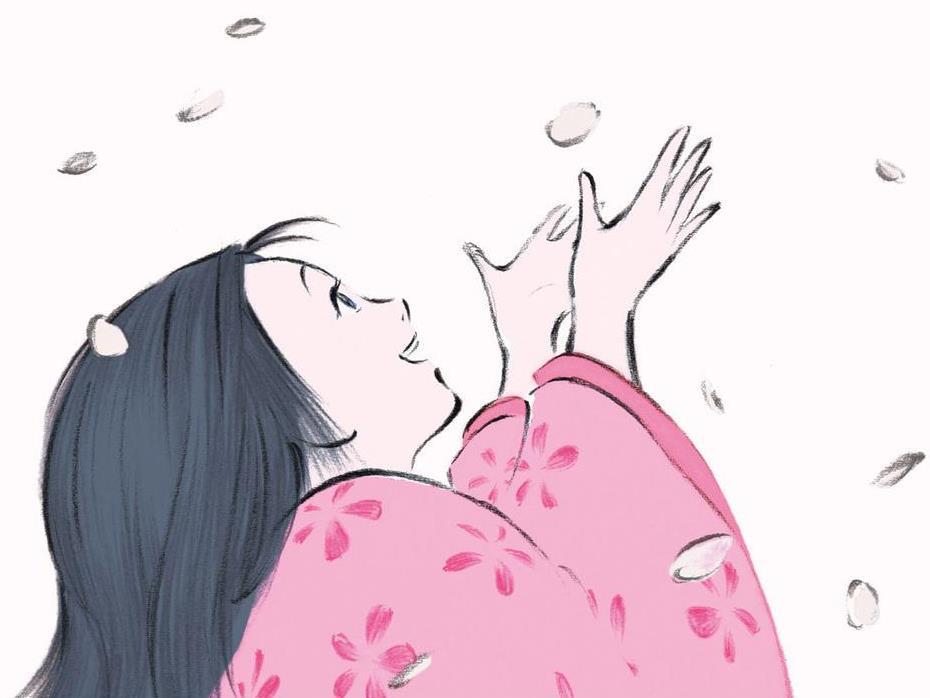With delicate pencil-thin lines and careful splashes of pastel watercolour, The Tale of Princess Kaguya (Kaguyahime no monogatari) comes to the screen as the sum of humble parts. Absent the glossy computer-generated sheen that marks most modern animated efforts, it transforms the unassuming into the affecting, one hand-drawn frame after another. In Isao Takahata’s first Studio Ghibli effort since 1999’s My Neighbors the Yamadas, it is the elemental and earthy that echoes. Splendour springs from simplicity as the film evokes empathy, elegance and earnestness.
It is The Tale of the Bamboo Cutter that The Tale of Princess Kaguya adapts, dating back to the 10th century to be considered the oldest Japanese story still in existence. The material’s two titles give rise to its main characters: the plant-felling farmer, Okina (Takeo Chii, TV’s Kansatsui Shinomiya Hazuki), toiling away in the forest to provide for his wife, Ona (Nobuko Miyamoto, Amachan), and the diminutive girl he finds secreted away in a shining stalk of bamboo. Okina dubs the child Princess (Aki Asakura, Nemureru mori no jukujo), and under his care she blossoms so fast that it defies belief. Maturing into a kind, caring young woman, she is at home in her rural surroundings and never happier than when frolicking with youthful hunter, Sutemaru (Kengo Kora, Roommate), and his friends.
When Okina stumbles upon a bounty of gold and silk in the same section of the forest, he becomes convinced that his adopted daughter is destined for bigger and better things. Determined to lift her fortunes as well as his own, he arranges her training in the mannerisms needed to be deemed a noblewoman, seeks five suitors to take her hand in marriage, and anoints her with the name Kaguya. Word spreads of the Princess’ loveliness, yet the life before her is not the one she covets. Her efforts are spent defying duty and resisting the restrictions enforced by the men in her orbit.
From its endearing opening, The Tale of Princess Kaguya’s aesthetic discretion quickly proves breathtakingly appropriate: for its company of origin, even if the feature looks little like other Ghibli works, and for a film steeped in finding fulfilment by following the plainest, purest path. As conveyed through expressive animation, the feature actively immerses viewers into the mindset of its protagonist, from her relishing of an ordinary life she loves, to her rallying against the enforcement of social-climbing luxury – and including spectacular dream sequences that speak to her inner vibrancy.
Wrestling with a passion project so engrained that Takahata once worked on an aborted version over half a century ago, the writer/director and his co-scribe Riko Sakaguchi (The Little Maestro) revel in an oft-told narrative not of outlandish occurrences but of accepting one’s true nature. From Hans Christian Anderson’s Thumbelina to family fantasy feature The Odd Life of Timothy Green, the impact of children sprouted from non-traditional sources is a common narrative – and though The Tale of Princess Kaguya tells of the lessons learned by those she touches, it is never anything other than the rebellious titular character’s story.
Despite magical flourishes that seem headed for standard fairytale territory, it is the subversion of typical depictions that the soft and dreamy film celebrates. The movie’s muse, the girl of its moniker, is more than just a catalyst for change in those around her, fighting against the compliance traditionally required of her gender and station. Her independence and influence within the world of the story is unmistakable, but it is her symbolism that engages as much as the details of the glacially paced, episodic account of her life. Reflectively and with resonance, she challenges the prevailing view that her status as a woman from rural surroundings is anything other than desirable, in keeping with Studio Ghibli’s favoured feminist and environmentalist themes.
Accordingly, The Tale of Princess Kaguya assembles its modest components – leisurely yet lively animation, a mixture of myth and meditation in narrative, and a suitably sweet and wistful score from Joe Hisaishi (The Wind Rises) – into an equally touching and thoughtful filmic fable. The feature is rumoured to be Takahata’s last after a career that has also wrought Grave of the Fireflies and Pom Poko, and if that proves true, by adding yet another gorgeous, graceful and gentle allegory to his oeuvre, he ends in fine fashion.
Rating: 4 stars out of 5
The Tale of Princess Kaguya (Kaguyahime no monogatari)
Director: Isao Takahata
Japan, 2013, 137 mins
Distributor: Madman
Rated: PG
The Tale Of Studio Ghibli Showcase: Celebrating The Genius Of Hayao Miyazaki And Isao Takahata
OCTOBER 9-22
Melbourne / Cinema Nova
Sydney / Dendy Newtown
Canberra / Dendy Canberra
Brisbane / Dendy Portside
Hobart / State Cinema
OCTOBER 30 – NOVEMBER 12
Perth / Luna Leederville
NOVEMBER 27 – DECEMBER 10
Adelaide / Palace Nova East End
Actors:
Director:
Format:
Country:
Release:





